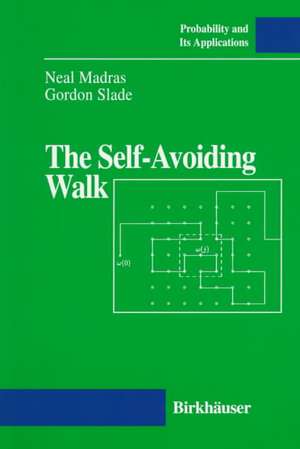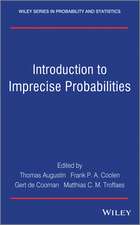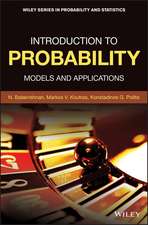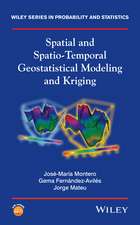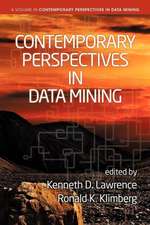The Self-Avoiding Walk: Probability and Its Applications
Autor Neal Madras, Gordon Sladeen Limba Engleză Paperback – 28 aug 1996
| Toate formatele și edițiile | Preț | Express |
|---|---|---|
| Paperback (2) | 534.69 lei 43-57 zile | |
| Springer – 7 noi 2012 | 534.69 lei 43-57 zile | |
| Birkhäuser Boston – 28 aug 1996 | 648.24 lei 43-57 zile |
Din seria Probability and Its Applications
-
 Preț: 392.60 lei
Preț: 392.60 lei -
 Preț: 395.09 lei
Preț: 395.09 lei - 18%
 Preț: 739.00 lei
Preț: 739.00 lei - 18%
 Preț: 783.35 lei
Preț: 783.35 lei - 15%
 Preț: 640.24 lei
Preț: 640.24 lei - 18%
 Preț: 948.47 lei
Preț: 948.47 lei -
 Preț: 391.99 lei
Preț: 391.99 lei - 18%
 Preț: 1399.43 lei
Preț: 1399.43 lei - 15%
 Preț: 471.21 lei
Preț: 471.21 lei - 20%
 Preț: 569.10 lei
Preț: 569.10 lei - 15%
 Preț: 691.08 lei
Preț: 691.08 lei -
 Preț: 385.08 lei
Preț: 385.08 lei - 18%
 Preț: 1123.19 lei
Preț: 1123.19 lei -
 Preț: 393.52 lei
Preț: 393.52 lei - 15%
 Preț: 646.62 lei
Preț: 646.62 lei -
 Preț: 461.65 lei
Preț: 461.65 lei - 18%
 Preț: 787.91 lei
Preț: 787.91 lei - 15%
 Preț: 702.41 lei
Preț: 702.41 lei - 15%
 Preț: 557.27 lei
Preț: 557.27 lei -
 Preț: 382.36 lei
Preț: 382.36 lei - 18%
 Preț: 1120.99 lei
Preț: 1120.99 lei - 18%
 Preț: 786.49 lei
Preț: 786.49 lei - 15%
 Preț: 655.78 lei
Preț: 655.78 lei - 18%
 Preț: 785.68 lei
Preț: 785.68 lei -
 Preț: 385.25 lei
Preț: 385.25 lei - 15%
 Preț: 701.90 lei
Preț: 701.90 lei - 18%
 Preț: 915.79 lei
Preț: 915.79 lei - 18%
 Preț: 1345.87 lei
Preț: 1345.87 lei - 18%
 Preț: 733.65 lei
Preț: 733.65 lei -
 Preț: 384.31 lei
Preț: 384.31 lei - 15%
 Preț: 582.80 lei
Preț: 582.80 lei -
 Preț: 361.42 lei
Preț: 361.42 lei - 15%
 Preț: 709.09 lei
Preț: 709.09 lei - 15%
 Preț: 644.95 lei
Preț: 644.95 lei - 18%
 Preț: 897.02 lei
Preț: 897.02 lei - 15%
 Preț: 528.13 lei
Preț: 528.13 lei - 15%
 Preț: 727.59 lei
Preț: 727.59 lei - 15%
 Preț: 470.88 lei
Preț: 470.88 lei - 18%
 Preț: 1001.81 lei
Preț: 1001.81 lei - 18%
 Preț: 954.14 lei
Preț: 954.14 lei -
 Preț: 392.60 lei
Preț: 392.60 lei - 15%
 Preț: 652.31 lei
Preț: 652.31 lei - 18%
 Preț: 1396.43 lei
Preț: 1396.43 lei - 18%
 Preț: 966.15 lei
Preț: 966.15 lei - 18%
 Preț: 1335.93 lei
Preț: 1335.93 lei
Preț: 648.24 lei
Preț vechi: 762.64 lei
-15% Nou
Puncte Express: 972
Preț estimativ în valută:
124.08€ • 134.82$ • 104.29£
124.08€ • 134.82$ • 104.29£
Carte tipărită la comandă
Livrare economică 21 aprilie-05 mai
Preluare comenzi: 021 569.72.76
Specificații
ISBN-13: 9780817638917
ISBN-10: 0817638911
Pagini: 427
Ilustrații: XIV, 427 p.
Dimensiuni: 155 x 235 x 22 mm
Greutate: 0.64 kg
Ediția:1996
Editura: Birkhäuser Boston
Colecția Birkhäuser
Seria Probability and Its Applications
Locul publicării:Boston, MA, United States
ISBN-10: 0817638911
Pagini: 427
Ilustrații: XIV, 427 p.
Dimensiuni: 155 x 235 x 22 mm
Greutate: 0.64 kg
Ediția:1996
Editura: Birkhäuser Boston
Colecția Birkhäuser
Seria Probability and Its Applications
Locul publicării:Boston, MA, United States
Public țintă
ResearchCuprins
1 Introduction.- 1.1 The basic questions.- 1.2 The connective constant.- 1.3 Generating functions.- 1.4 Critical exponents.- 1.5 The bubble condition.- 1.6 Notes.- 2 Scaling, polymers and spins.- 2.1 Scaling theory.- 2.2 Polymers.- 2.3 The N ? 0 limit.- 2.4 Notes.- 3 Some combinatorial bounds.- 3.1 The Hammersley-Welsh method.- 3.2 Self-avoiding polygons.- 3.3 Kesten’s bound on cN.- 3.4 Notes.- 4 Decay of the two-point function.- 4.1 Properties of the mass.- 4.2 Bridges and renewal theory.- 4.3 Separation of the masses.- 4.4 Ornstein-Zernike decay of GZ(0, x).- 4.5 Notes.- 5 The lace expansion.- 5.1 Inclusion-exclusion.- 5.2 Algebraic derivation of the lace expansion.- 5.3 Example: the memory-two walk.- 5.4 Bounds on the lace expansion.- 5.5 Other models.- 5.6 Notes.- 6 Above four dimensions.- 6.1 Overview of the results.- 6.2 Convergence of the lace expansion.- 6.3 Fractional derivatives.- 6.4 cn and the mean-square displacement.- 6.5 Correlation length and infrared bound.- 6.6 Convergence to Brownian motion.- 6.7 The infinite self-avoiding walk.- 6.8 The bound on cn(0,x).- 6.9 Notes.- 7 Pattern theorems.- 7.1 Patterns.- 7.2 Kesten’s Pattern Theorem.- 7.3 The main ratio limit theorem.- 7.4 End patterns.- 7.5 Notes.- 8 Polygons, slabs, bridges and knots.- 8.1 Bounds for the critical exponent ?sing.- 8.2 Walks with geometrical constraints.- 8.3 The infinite bridge.- 8.4 Knots in self-avoiding polygons.- 8.5 Notes.- 9 Analysis of Monte Carlo methods.- 9.1 Fundamentals and basic examples.- 9.2 Statistical considerations.- 9.3 Static methods.- 9.4 Length-conserving dynamic methods.- 9.5 Variable-length dynamic methods.- 9.6 Fixed-endpoint methods.- 9.7 Proofs.- 9.8 Notes.- 10 Related topics.- 10.1 Weak self-avoidance and the Edwards model.- 10.2 Loop-erased randomwalk.- 10.3 Intersections of random walks.- 10.4 The “myopic” or “true” self-avoiding walk.- A Random walk.- B Proof of the renewal theorem.- C Tables of exact enumerations.- Notation.
Recenzii
"An excellent introduction for graduate students and professional probabilists... The best place to find a self-contained exposition of lace expansion."
—Bulletin of the AMS
"As a carefully written and carefully referenced exposition of an intriguing topic...this monograph is strongly recommended."
—Monatshefte Mathematik
"In this book, the reader will find basically everything there is to know about rigorous mathematical results on self-avoiding walks... It is nicely written and should be read by mathematical physicists and probabilists interested in applications to natural sciences."
—Belgian Mathematical Society
"This is the first book on self-avoiding random walk and a very good one."
—SIAM Review
"An excellent book that should be on the shelf of anyone doing work at the intersection of probability and critical phenomena... The best results about the SAW can still be found here."
--Annals of Probability
—Bulletin of the AMS
"As a carefully written and carefully referenced exposition of an intriguing topic...this monograph is strongly recommended."
—Monatshefte Mathematik
"In this book, the reader will find basically everything there is to know about rigorous mathematical results on self-avoiding walks... It is nicely written and should be read by mathematical physicists and probabilists interested in applications to natural sciences."
—Belgian Mathematical Society
"This is the first book on self-avoiding random walk and a very good one."
—SIAM Review
"An excellent book that should be on the shelf of anyone doing work at the intersection of probability and critical phenomena... The best results about the SAW can still be found here."
--Annals of Probability
Textul de pe ultima copertă
The self-avoiding walk is a mathematical model that has important applications in statistical mechanics and polymer science. In spite of its simple definition—a path on a lattice that does not visit the same site more than once—it is difficult to analyze mathematically. The Self-Avoiding Walk provides the first unified account of the known rigorous results for the self-avoiding walk, with particular emphasis on its critical behavior. Its goals are to give an account of the current mathematical understanding of the model, to indicate some of the applications of the concept in physics and in chemistry, and to give an introduction to some of the nonrigorous methods used in those fields.
Topics covered in the book include: the lace expansion and its application to the self-avoiding walk in more than four dimensions where most issues are now resolved; an introduction to the nonrigorous scaling theory; classical work of Hammersley and others; a new exposition of Kesten’s pattern theorem and its consequences; a discussion of the decay of the two-point function and its relation to probabilistic renewal theory; analysis of Monte Carlo methods that have been used to study the self-avoiding walk; the role of the self-avoiding walk in physical and chemical applications. Methods from combinatorics, probability theory, analysis, and mathematical physics play important roles. The book is highly accessible to both professionals and graduate students in mathematics, physics, and chemistry.
Topics covered in the book include: the lace expansion and its application to the self-avoiding walk in more than four dimensions where most issues are now resolved; an introduction to the nonrigorous scaling theory; classical work of Hammersley and others; a new exposition of Kesten’s pattern theorem and its consequences; a discussion of the decay of the two-point function and its relation to probabilistic renewal theory; analysis of Monte Carlo methods that have been used to study the self-avoiding walk; the role of the self-avoiding walk in physical and chemical applications. Methods from combinatorics, probability theory, analysis, and mathematical physics play important roles. The book is highly accessible to both professionals and graduate students in mathematics, physics, and chemistry.
Caracteristici
Affordable reprint of a classic monograph Provides a focused look at an important mathematical model Includes an introduction to methods used in physics and chemistry
